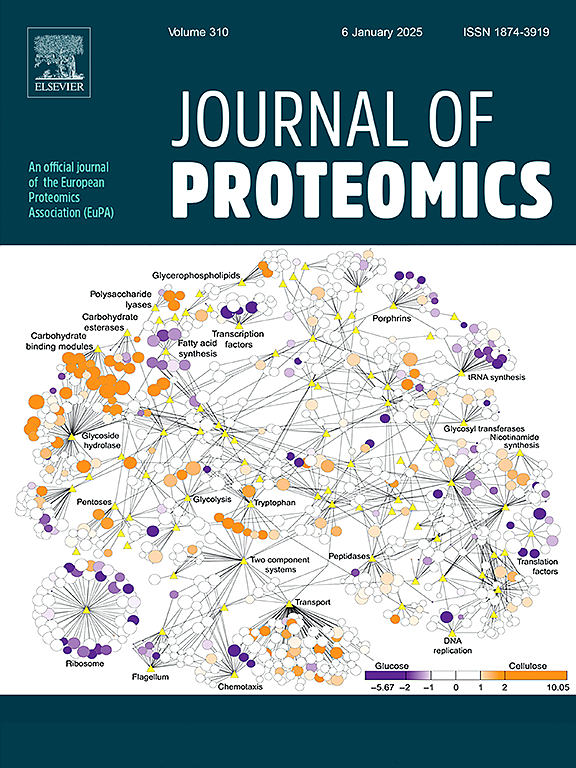Unraveling the mechanism of peptidases participation in the protein digestion of the whiteleg shrimp (Litopenaeus vannamei)
IF 2.8
2区 生物学
Q2 BIOCHEMICAL RESEARCH METHODS
引用次数: 0
Abstract
This study aims to identify and analyze the temporal variation in the activity and relative abundance of peptidases in the midgut gland of the Pacific whiteleg shrimp, Litopenaeus vannamei, during digestion. The dynamic profiles of active peptidases throughout digestion were determined by zymogram profile analysis in the midgut gland of shrimp at different feeding times: preprandial, 1 h, and 3 h postprandial. Further proteomic analysis of midgut gland extracts confirmed the identity of different-class peptidases, as well as additional isoforms not previously reported, and changes in their relative abundance. Trypsins and chymotrypsins were the predominantly active peptidases throughout the digestion process. Cathepsin D was active during the preprandial time and 3 h after ingestion, whereas a metallopeptidase showed activity at preprandial time and 1 h postprandial. Additional trypsin isoforms of varying abundances were confirmed, while chymotrypsins and cathepsin L increased significantly, peaking 3 h postprandial. The results indicate significant changes in the relative abundance of new isoforms of trypsins, cathepsins, and metallopeptidases, as well as in the previously identified peptidases involved in shrimp food protein digestion over time.
Significance
The manuscript findings revealed the peptidases' potential participation in the digestive process of the Pacific whiteleg shrimp. The integrated results from different methods confirmed the identity and active state of some of the multiple peptidase classes in the shrimp midgut gland.
Additional trypsin, cathepsin, and metallopeptidase isoforms and their abundance changes were detected before and after ingestion. These results provide additional information about the complexity and efficiency of the protein hydrolysis mechanism of L. vannamei.

揭示肽酶参与白对虾(凡纳滨对虾)蛋白质消化的机制
本研究旨在鉴定和分析凡纳滨对虾(Litopenaeus vannamei)消化过程中中肠腺肽酶活性和相对丰度的时间变化。通过酶谱分析,确定了不同饲喂时间(餐前、餐后1 h和3 h)对虾中肠腺中活性肽酶在消化过程中的动态变化。对中肠腺提取物的进一步蛋白质组学分析证实了不同类别肽酶的同一性,以及先前未报道的其他异构体,以及它们相对丰度的变化。胰蛋白酶和凝乳胰蛋白酶是整个消化过程中主要的活性肽酶。组织蛋白酶D在餐前和进食后3 h有活性,而金属肽酶在餐前和餐后1 h有活性。其他不同丰度的胰蛋白酶异构体被证实,而凝乳胰蛋白酶和组织蛋白酶L显著增加,餐后3 h达到峰值。结果表明,随着时间的推移,胰蛋白酶、组织蛋白酶和金属肽酶的新异构体的相对丰度以及先前确定的与虾食物蛋白质消化有关的肽酶发生了显著变化。意义:研究结果揭示了肽酶可能参与太平洋白螯虾的消化过程。不同方法的综合结果证实了虾中肠腺中某些多肽酶的同一性和活性状态。在摄入前后检测其他胰蛋白酶、组织蛋白酶和金属肽酶异构体及其丰度变化。这些结果为瓦纳梅蛋白水解机制的复杂性和效率提供了更多的信息。
本文章由计算机程序翻译,如有差异,请以英文原文为准。
求助全文
约1分钟内获得全文
求助全文
来源期刊

Journal of proteomics
生物-生化研究方法
CiteScore
7.10
自引率
3.00%
发文量
227
审稿时长
73 days
期刊介绍:
Journal of Proteomics is aimed at protein scientists and analytical chemists in the field of proteomics, biomarker discovery, protein analytics, plant proteomics, microbial and animal proteomics, human studies, tissue imaging by mass spectrometry, non-conventional and non-model organism proteomics, and protein bioinformatics. The journal welcomes papers in new and upcoming areas such as metabolomics, genomics, systems biology, toxicogenomics, pharmacoproteomics.
Journal of Proteomics unifies both fundamental scientists and clinicians, and includes translational research. Suggestions for reviews, webinars and thematic issues are welcome.
 求助内容:
求助内容: 应助结果提醒方式:
应助结果提醒方式:


